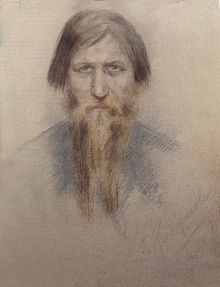Elena Nikandrovna Klokacheva
Elena Nikandrovna Klokacheva (Template:Lang-ru, also known as Klakachova (Клакачова) and Klakacheva (Клакачева); Saint Petersburg, Russia, 25 November 1871 – not before 1943), was a painter mainly known by one of the few existing portraits of Rasputín, now at the Hermitage. In 1942 and 1943, during the Siege of Leningrad, she draw some portraits of Spanish military physicians belonging to the Wehrmacht Blue Division.
Biography
Elena Nikandrovna Klokacheva was born the in a distinguished navy officers family. Fedot Alekséevich Klokachev (Федот Алексеевич Клокачёв,1739-1783), Vice admiral of the Black Sea fleet, was Klokacheva's great-great-grandfather. Her father, Nikandr Nikolaevich Klokachev (Никандр Николаевич Клокачёв), was Rear admiral.[1]
Since 1902 she appeared in the directory All Petersburg (Весь Петербург), sometimes as Klokacheva and others as Klakacheva, with different addresses. Since 1906 she lived in Serguiévskaya street that changed its name to Chaikovskogo street in 1923. From 1917 on, her name disappears from the directory.[2]
In 1910, the writer Evdokiia Nagródskaia (Евдокия Аполлоновна Нагродская) dedicated to Klokachova her novel The Wrath of Dionysus[3] (Гнев Диониса).

In 1942 and 1943, the Spanish Blue Division, participating in the Siege of Leningrad, had a field dressing station in Pavlovsk. Klokacheva made charcoal portraits of some of the Spanish military physicians on assignment there. Their families hold two of these portraits in Spain.
The date and place of her death are unknown.
Artistic career
She studied painting at the Imperial Academy of Arts in Saint Petersburg (Императорская Академия Xудожеств); during 1891 and 1892 with Pavel Chistiakov and then with Pavel Kovalevsky (Па́вел О́сипович Ковале́вский). In 1899 she went to Munich to study with the Slovene painter Anton Ažbe and with Franz von Lenbach.
In 1901 she was entitled "artist” (Russian: художника) for her picture “Behind the scenes” (За кулисами). The Academy had accepted "full membership" of women just in 1873.[4]
In 1907, the Academy acquired her work At the circus; her picture Hard days and a portrait of her friend, the art historian Olga Bazankur (Ольга Георгиевна Базанкур-Штейнфельд) were exhibited in Saint Petersburg and Moscow.[5]
In 1909 she took part in the "spring" exhibition at the Imperial Academy of Arts with her work “Satyr and nymph”.[6]
Klokacheva participated in the artistic circles of her time in Saint Petersburg; she was friend with the writers Nadezhda Aleksandrovna Lujmanova (Надежда Александровна Лухманова) and Evdokiia Nagródskaia. At the Imperial Academy some of her colleagues were Maria Alekseevna Fedorova (Мария Алексеевна Фёдорова), Elizabeta Mijailovna Martynova (Елизавета Михайловна Мартынова), and Anna Petrovna Ostroumova-Lebedeva. She posed for the photographer Elena Lukinichna Mrozovskaya -Helène de Mrosovsky- (Елена Лукинична Мрозовская).
Work

- Portrait of Rasputin, signed and dated in 1914, colour pencils and pastel on grey card, 81.5 x 56 cm
- A scene from the life of the Boyars (Сцена из боярской жизни), signed, oil on canvas, 107 x 76 cm
- Portrait of the writer Piotr Petrovich Gnedich (Петр Петрович Гнедич, 1865-1925). Published in the magazine Niva (Нива), Saint Petersburg, 1869-1918
- Icarus (Икар), reproduced in postcards at the turn of the 20th century
- The warrior (Витязь), reproduced in postcards at the turn of the 20th century
- Love (Любовь), reproduced in postcards at the turn of the 20th century
- At the roof (На крышах), reproduced in postcards at the turn of the 20th century
- Dream (Мечты), reproduced in postcards at the turn of the 20th century
- Satyr and nymph (Сатир и нимфа), reproduced in postcards at the turn of the 20th century
- At the circus (В цирке)
- Hard days (Тяжелые дни)
- Portrait of Olga Bazankur
References
- ^ "Ошибка 404. Страница удалена или временно не доступна - Национальная библиотека Республики Карелия". library.karelia.ru. Retrieved 2016-08-25.
- ^ библиотека, Российская национальная. "Интерактивное оглавление к электронным копиям адресных и справочных книг «Весь Петербург — Весь Петроград» (1894-1917). Справка". www.nlr.ru. Retrieved 2016-08-25.
- ^ "The Wrath of Dionysus". Indiana University Press. Retrieved 2016-08-25.
- ^ "Козлова Н. Н. Реферат кн.: Остроумова-Лебедева А. П. Автобиографические записки. Т. 1, 2, 3". www.a-z.ru. Retrieved 2016-08-25.
- ^ "1907. Иллюстрированный каталог XV выставки в Москве". Retrieved 2016-08-25.
- ^ "Proshly Vek: Russian and Soviet Fine Art Gallery of the XX Century".
